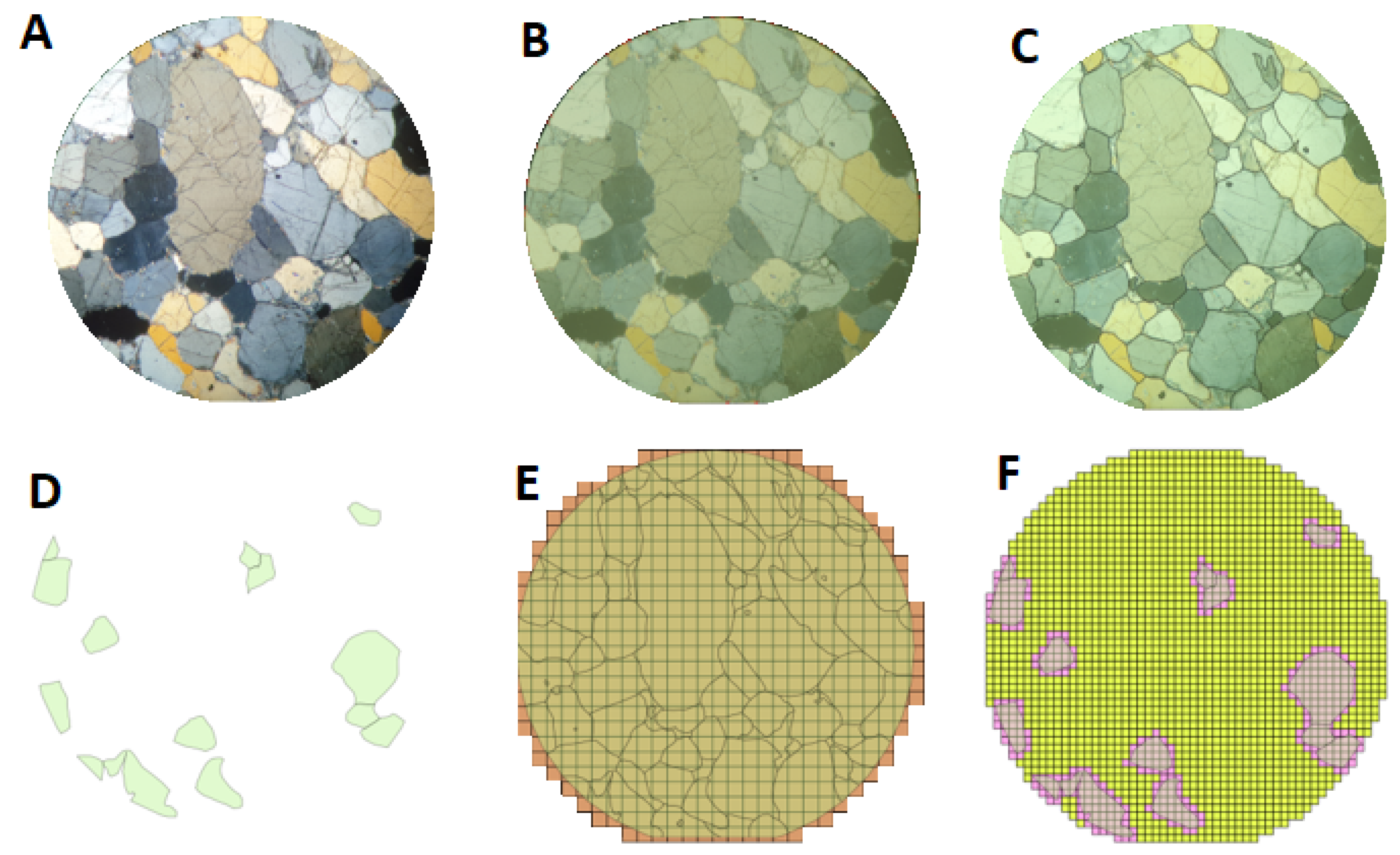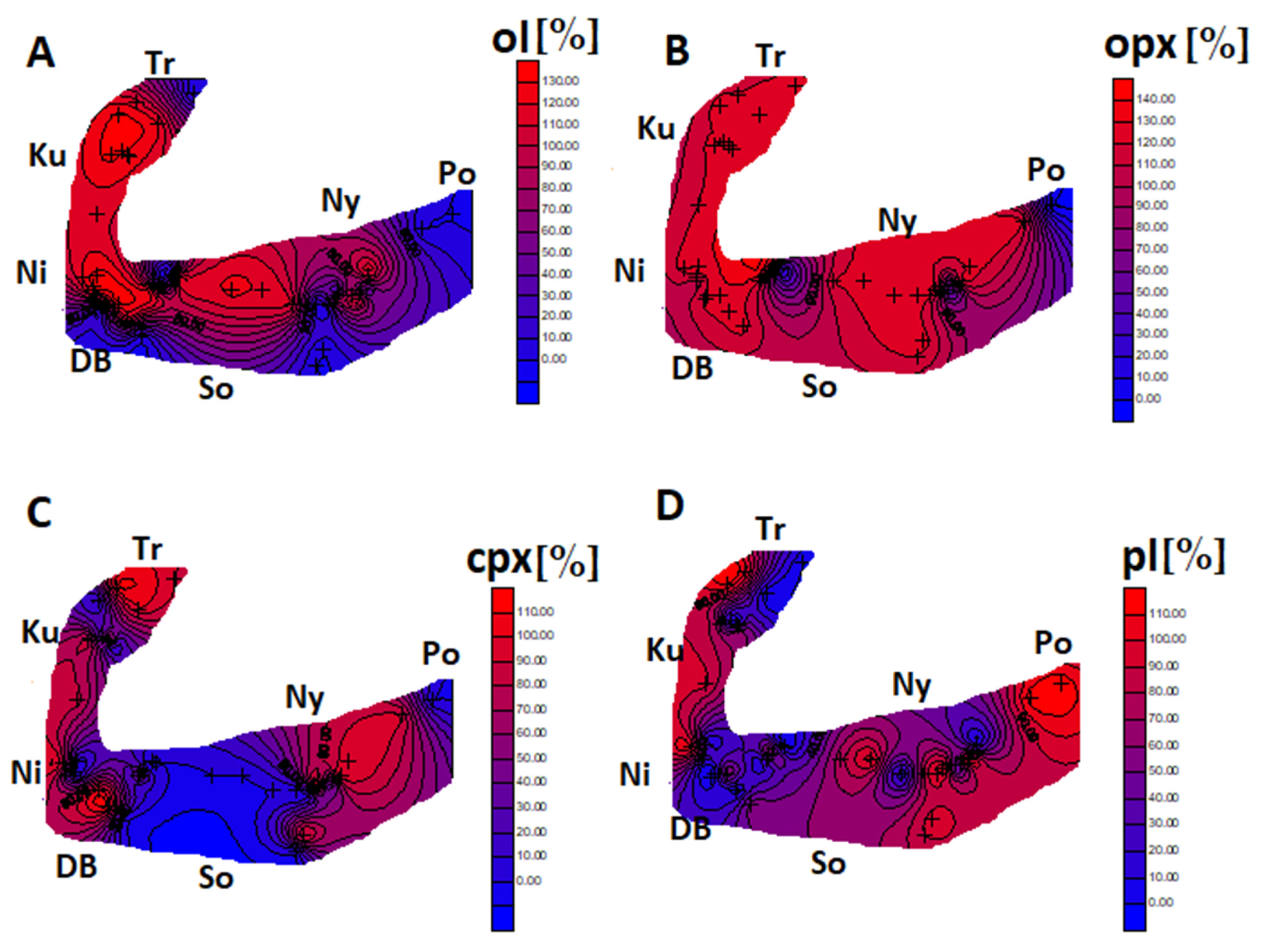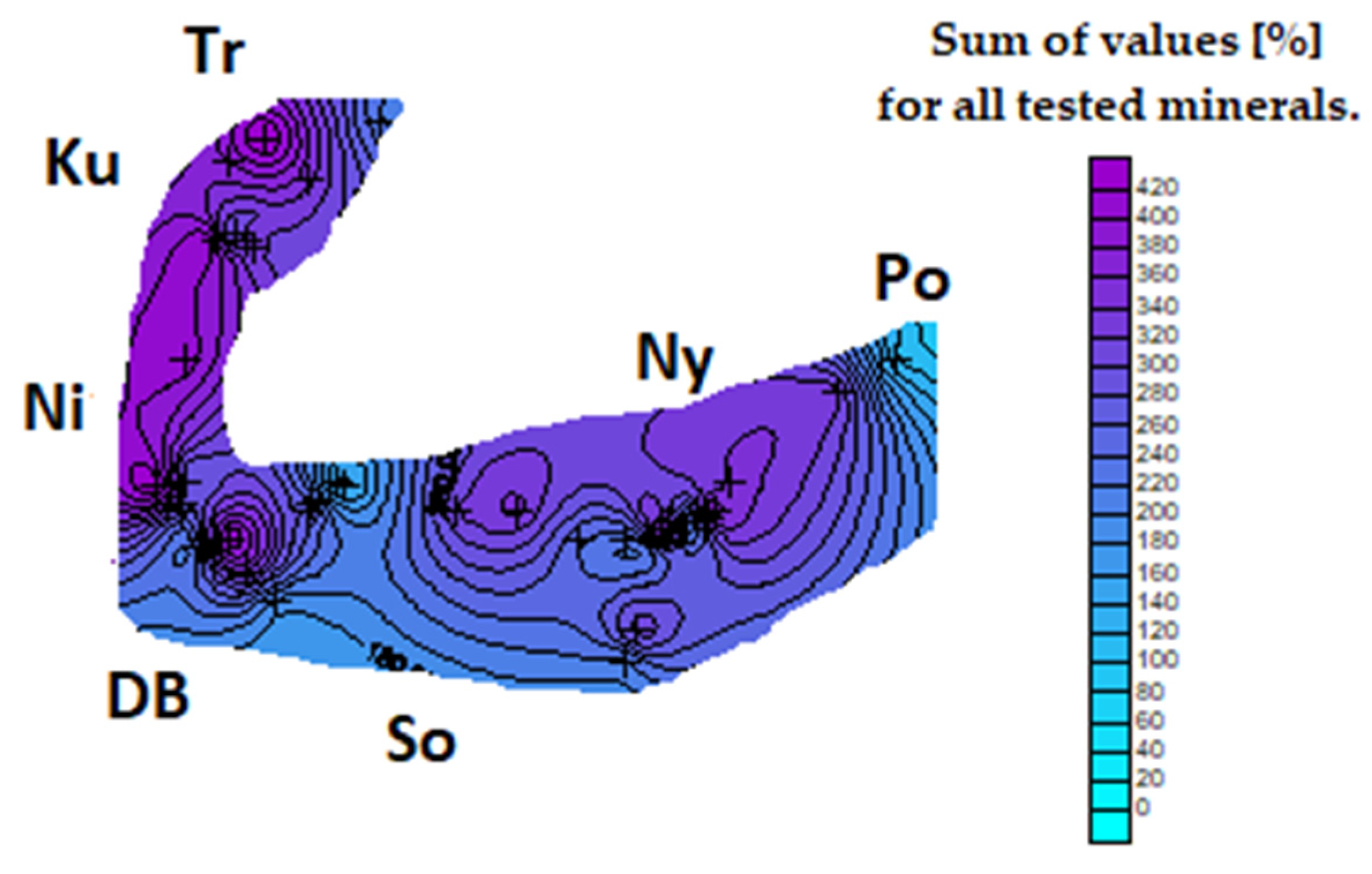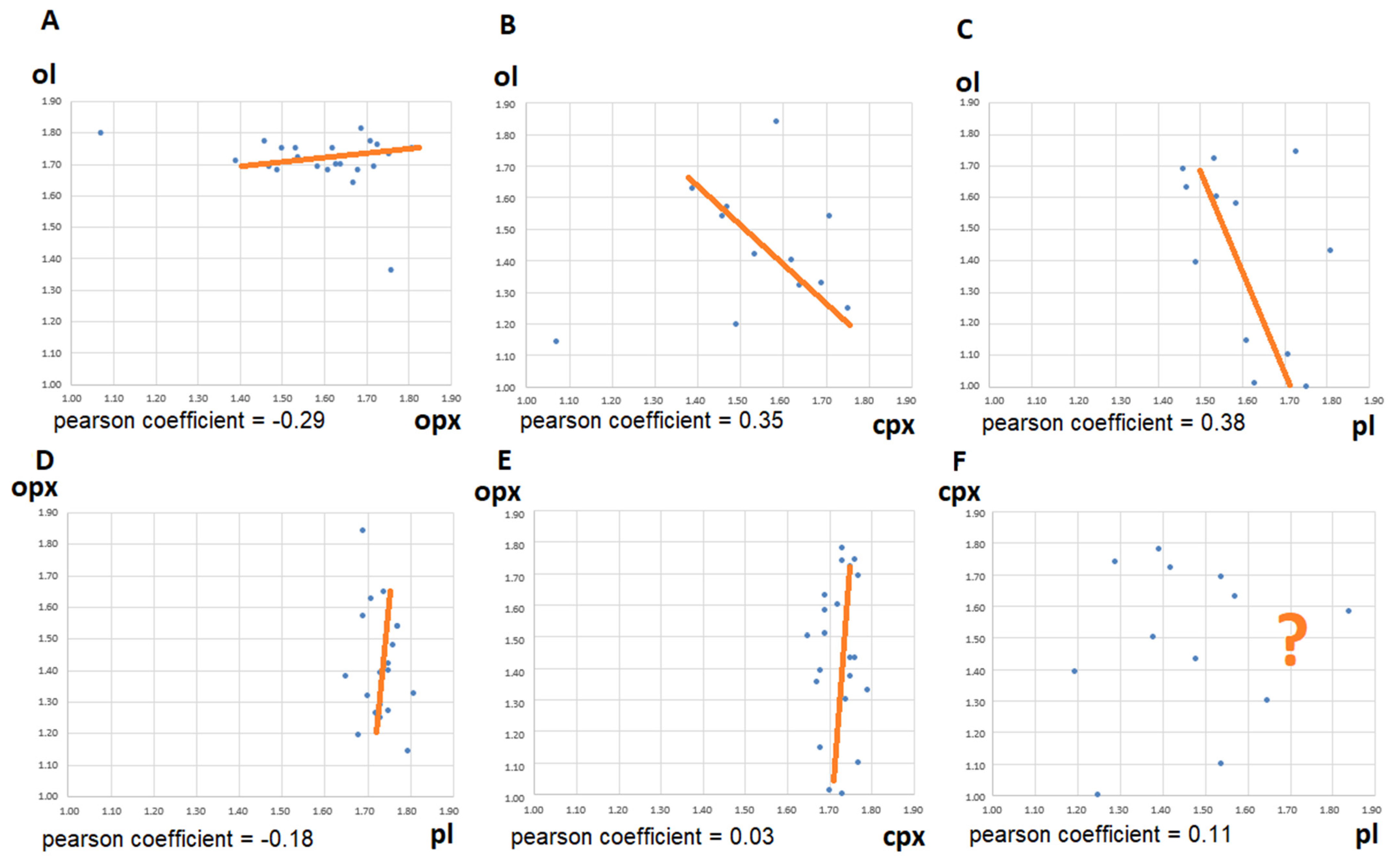Application of the Fractal Dimension Calculation Technique to Determine the Shape of Selected Monchepluton Intrusion Crystals (NE Fennoscandia)
Abstract
1. Introduction
2. Materials and Methods
3. Results
3.1. Monchepluton Petrography
3.2. Rock-Forming Minerals Characteristic
3.3. Fractal Analysis Results
4. Discussion
5. Conclusions
Author Contributions
Funding
Data Availability Statement
Conflicts of Interest
References
- Chen, T.L.; Shi, Z.L.; Wen, A.; Yan, D.; Gou, J.; Chen, J.; Liu, Y.; Chen, R. Multifractal characteristics, and spatial variability of soil particle-size distribution in different l, and use patterns in a small catchment of the Three Gorges Reservoir Region. China J. Mt. Sci. 2021, 18, 111–125. [Google Scholar] [CrossRef]
- Gulbin, Y.L.; Evangulova, E.B. Morphometry of Quartz Aggregates in Granites: Fractal Images Referring to Nucleation, and Growth Processes. Math. Geol. 2003, 35, 819–833. [Google Scholar] [CrossRef]
- Kincal, C.; Koca, M.Y.; Ozden, G.; Demirbasa, N. Fractal parameter approach on weathering grade determination of Cesme (Izmir, Turkey) tuffs. Bull. Eng. Geol. Environ. 2010, 69, 617–629. [Google Scholar] [CrossRef]
- Lehmann, P.; Stahla, M.; Papritz, A.; Gygi, A.; Fluher, H. A Fractal Approach to Model Soil Structure, and to Calculate Thermal Conductivity of Soils. Transp. Porous Media 2003, 52, 313–332. [Google Scholar] [CrossRef]
- Martin, M.A.; Reyes, M. A Fractal Interaction Model for Winding Paths through Complex Distributions: Application to Soil Drainage Networks. Pure Appl. Geophys. 2008, 165, 1153–1165. [Google Scholar] [CrossRef][Green Version]
- Mohammadi, A.; Khakzad, A.; Omran, N.R.; Mahvi, M.R.; Moarefvand, P.; Afzal, P. Application of number–size (N-S) fractal model for separation of mineralized zones in Dareh-Ashki gold deposit, Muteh Complex. Central Iran. Arab J Geosci. 2013, 6, 4387–4398. [Google Scholar] [CrossRef]
- Zhengli, M.; Jian Qing, L.; Yang, B. The geochemical multi-fractal characteristics, and mineralization of the Dehelongwa copper-gold deposit. Chin. J. Geochem. 2014, 33, 280–288. [Google Scholar] [CrossRef]
- Słaby, E.; Domonik, A.; Śmigielski, M.; Majzner, K.; Motuza, G.; Goetze, J.; Simon, K.; Moszumańska, I.; Kruszewski, Ł.; Rydelek, P. Protomylonite evolution potentially revealed by the 3D depiction, and fractal analysis of chemical data from a feldspar. Contrib. Miner. Petrol. 2014, 167, 995. [Google Scholar] [CrossRef]
- Gerig, A.; Kruhl, J.H.; Caggianelli, A. Quantification of Flow Patterns in Sheared Tonalite Crystal-melt Mush: Application of Fractal-geometry Methods. J. Geol. Soc. India 2010, 75, 210–224. [Google Scholar] [CrossRef]
- Singh, A.K.; Upadhyay, D.; Pruseth, K.L.; Mezger, K.; Nanda, J.K.; Maiti, S.; Saha, D. Shock Metamorphic Features in the Archean Simlipal Complex, Singhbhum Craton, Eastern India: Possible Remnant of a Large Impact Structure. J. Geol. Soc. India 2021, 97, 35–47. [Google Scholar] [CrossRef]
- Voitsekhovsky, Y.L.; Shpachenko, A.K.; Skiba, V.I. Cell-zonal textures of tinguaites from the Kola Peninsula. Geol. Rundsch. 1997, 86, 531–538. [Google Scholar] [CrossRef]
- Zheru, Z.; Huahi, M.; Cheng, Q. Fractal Geometry of Element Distribution on Mineral Surfaces. Math. Geol. 2001, 33, 2. [Google Scholar] [CrossRef]
- Huber, M. Evolution of the Kola–Lapland Mobile Belt on the Example of Platinum–Bearing Paleoproterozoic Layered Monchepluton Intrusion; Maria Curie–Sklodowska University: Lublin, Poland, 2021. [Google Scholar]
- Mitrofanov, A.F. Geological Characteristics of the Kola Peninsula; Kola Scientific Center, Russian Academy of Sciences: Apatity, Russia, 2000; p. 166. [Google Scholar]
- Sharkov, E.V. Formation of Layered Intrusions, and Their Ore Mineralization; Moscov Scientific World: Moscow, Russia, 2006; p. 368. [Google Scholar]
- Bayanova, T.B. Age of Benchmark Geological Complexes of the Kola Region, and Magmatism Processes Action; Sankt Petersburg: Nauka, Russia, 2004; p. 174. [Google Scholar]
- Bayanova, T.; Korchagin, A.; Mitrofanov, A.; Serov, P.; Ekimova, N.; Nitkina, E.; Kamensky, I.; Elizarov, D.; Huber, M. Long-Lived Mantle Plume, and Polyphase Evolution of Palaeoproterozoic PGE Intrusions in the Fennoscandian Shield. Minerals 2019, 9, 59. [Google Scholar] [CrossRef]
- Pozhylienko, V.I.; Gavrilienko, B.V.; Zhirov, D.V.; Zhabin, S.V. Geology of the Ore Regions in Murmansk District; Kola Scientific Center, Russian Academy of Sciences: Apatity, Russia, 2002; p. 360. [Google Scholar]
- Hałas, S.; Huber, M.; Piestrzyński, A. Petrology of gabbroid, and isotope signature of sulfide mineralization from Fedorov-Pansky layered mafic intrusion, Kola Peninsula, Russia. Geochronometria 2009, 33, 19–22. [Google Scholar]
- Huber, M. Dynamics of metamorphism processes by the fractal textures analysis of garnets, amphibole, and pyroxenes of Lapland Granulite Belt, Kola Peninsula. J. Biol. Earth Sci. 2012, 2, 50–55. [Google Scholar]
- Lubnina, N.V.; Pasenko, A.M.; Novikova, M.A.; Bubnov, A.Y. The East European Craton at the End of the Paleoproterozoic: A New Paleomagnetic Pole of 1.79–1.75 Ga. Mosc. Univ. Geol. Bull. 2016, 71, 8–17. [Google Scholar] [CrossRef]
- Rundkvist, T.V.; Mokrushin, A.V.; Huber, M.; Pripachkin, P.V.; Bazai, A.V.; Miroshnikova, Y.A. New data on the composition of chrome spinellids in the rocks of the southeastern of the Early Proterozoic Monchegorsk complex (Kola region). Bull. Kola Sci. Cent. Russ. Acad. Sci. 2018, 1, 50–62. [Google Scholar] [CrossRef]
- Arzamastsev, A.A.; Fedotov, Z.A.; Arzamastseva, L.V. Dyke Magmatism of the N-E of Baltic Shield; Sankt Petersburg: Nauka, Russia, 2009; p. 383. [Google Scholar]
- Baltybaev, S.K. Svecofennian Orogen of the Fennoscandian Shield: Compositional, and Isotopic Zoning, and Its Tectonic Interpretation. Geotectonics 2013, 47, 452–464. [Google Scholar] [CrossRef]
- Mitrofanov, F.P.; Smolkin, V.F. Stratified Intrusions of the Monchegorsk Ore Region: Petrology, Mineralization, Isotopes, Deep Structure. In 2 Parts; Kola Scientific Center, Russian Academy of Sciences: Apatity, Russia, 2004; p. 344. [Google Scholar]
- Miyashiro, A. Metamorphic Petrology; CRC Press: Boca Raton, FL, USA, 1994; p. 416. [Google Scholar]
- Petigen, H.O.; Jürgens, H.; Saupe, D. Fractals for the Classroom; Springer: New York, NY, USA, 1992; p. 546. [Google Scholar]







| Sample | Massif | Latitude | Longitude | Sample | Massif | Latitude | Longitude |
|---|---|---|---|---|---|---|---|
| 46MON17 | Dunite Block | 67°53′57.4″ N | 32°45′59.0″ E | 32MON19 | Sopcha N | 67°53′36.30″ N | 32°48′53.32″ E |
| 02MON19 | Dunite Block | 67°53′49.09″ N | 32°44′57.01″ E | 39MON19 | Sopcha N | 67°53′36.31″ N | 32°48′53.35″ E |
| 56MON17 | Dunite Block | 67°53′57.4″ N | 32°45′59.0″ E | 40MON19 | Sopcha N | 67°53′36.32″ N | 32°48′53.38″ E |
| 67MON17 | Traviannaya | 67°56′33.0″ N | 32°49′03.3″ E | 38MON16 | Sopcha W | 67°53′29.7″ N | 32°49′59.1″ E |
| 01MON19 | Traviannaya | 67°56′38.15″ N | 32°48′40.18″E | 39MON16 | Sopcha W | 67°53′33.7″ N | 32°50′03.4″ E |
| 07MON18 | Traviannaya | 67°56′38.2″ N | 32°48′40.2″ E | 42MON16 | Sopcha W | 67°53′40.5″ N | 32°50′11.0″ E |
| 84MON17 | Traviannaya | 67°56′32.4″ N | 32°48′08.3″ E | 43MON16 | Sopcha W | 67°53′40.52″ N | 32°50′11.05″ E |
| 03MON19 | Kumuzhia | 67°55′44.3″ N | 32°48′03.9″ E | 44MON16 | Sopcha W | 67°53′49.5″ N | 32°49′54.6″ E |
| 04MON19 | Kumuzhia | 67°55′45,55″ N | 32°47′29.51″ E | 45MON16 | Sopcha W | 67°53′49.51″ N | 32°49′54.63″ E |
| 05MON19 | Kumuzhia | 67°55′45,54″ N | 32°47′29.53″ E | 08MON17 | Nyud | 67°53′11.3″ N | 32°53′57.3″ E |
| 07MON19 | Kumuzhia | 67°55′50.88″ N | 32°47′26.16″ E | 09MON17 | Nyud | 67°53′11.3″ N | 32°53′57.3″ E |
| 18MON19 | Nittis | 67°55′05.48″ N | 32°45′32.88″ E | 14MON17 | Nyud | 67°53′29.15″ N | 32°54′48.02″ E |
| 29MON17 | Sopcha E | 67°53′09.2″ N | 32°52′48.6″ E | 15MON17 | Nyud | 67°53′29.2″ N | 32°54′48.1″ E |
| 30MON17 | Sopcha E | 67°53′09.2″ N | 32°52′48.6″ E | 16MON17 | Nyud | 67°53′31.7″ N | 32°54′55.7″ E |
| 31MON17 | Sopcha E | 67°53′09.24″ N | 32°52′48.6″ E | 20MON17 | Nyud | 67°53′31.75″ N | 32°54′55.77″ E |
| 32MON17 | Sopcha E | 67°53′09.25″ N | 32°52′48.6″ E | 22MON17 | Nyud | 67°53′38.3″ N | 32°55′21.1″ E |
| 34MON17 | Sopcha E | 67°53′23.3″ N | 32°52′05.1″ E | 24MON17 | Nyud | 67°53′38.2″ N | 32°55′22.4″ E |
| 38MON17 | Sopcha E | 67°53′41.7″ N | 32°51′17.2″ E | 58MON17 | Poaz | 67°54′58.5″ N | 32°58′36.0″ E |
| 31MON19 | Sopcha N | 67°53′36.30″ N | 32°48′53.30″ E | 61MON17 | Poaz | 67°54′56.5″ N | 32°58′20.5″ E |
| Sample | Fractal Analysis Results | Massif | Sample | Fractal Analysis Results | Massif | ||||||
|---|---|---|---|---|---|---|---|---|---|---|---|
| ol | opx | cpx | pl | ol | opx | cpx | pl | ||||
| 46MON17 | 1.81 | 1.75 | 1.43 | Dunite Block | 40MON19 | 1.61 | Sopcha N | ||||
| 52MON17 | 1.76 | 1.36 | Dunite Block | 38MON16 | 1.39 | 1.71 | 1.63 | Sopcha W | |||
| 02MON19 | 1.53 | 1.75 | 1.42 | 1.72 | Dunite Block | 39MON16 | 1.74 | 0.87 | Sopcha W | ||
| 03MON19 | 1.63 | 1.70 | 1.01 | Kumuzhia | 42MON16 | 1.71 | 1.77 | 1.54 | 1.10 | Sopcha W | |
| 04MON19 | 1.69 | 1.81 | 1.33 | Kumuzhia | 43MON16 | 1.72 | 1.26 | Sopcha W | |||
| 05MON19 | 1.67 | 1.64 | Kumuzhia | 44MON16 | 1.07 | 1.80 | 1.14 | Sopcha W | |||
| 07MON19 | 1.75 | 1.73 | 1.25 | 1.00 | Kumuzhia | 45MON16 | 1.72 | 1.69 | Sopcha W | ||
| 18MON19 | 1.49 | 1.68 | 1.19 | 1.39 | Nittis | 08MON17 | 1.79 | 1.33 | Nyud | ||
| 58MON17 | 1.73 | 1.29 | 1.74 | Poaz | 09MON17 | 1.69 | 1.51 | Nyud | |||
| 61MON17 | 1.77 | Poaz | 14MON17 | 1.58 | 1.69 | 1.84 | 1.58 | Nyud | |||
| 29MON17 | 1.50 | 1.75 | Sopcha E | 15MON17 | 1.65 | 1.38 | 1.50 | Nyud | |||
| 31MON17 | 1.76 | 1.48 | 1.43 | Sopcha E | 16MON17 | 1.76 | Nyud | ||||
| 32MON17 | 1.67 | 1.35 | Sopcha E | 20MON17 | 1.46 | 1.77 | 1.54 | 1.69 | Nyud | ||
| 34MON17 | 1.54 | 1.72 | 1.60 | Sopcha E | 22MON17 | 1.73 | 1.39 | 1.78 | Nyud | ||
| 38MON17 | 1.61 | 1.68 | 1.15 | Sopcha E | 24MON17 | 1.64 | 1.70 | 1.32 | Nyud | ||
| 30MON17 | 1.74 | 1.65 | 1.30 | Sopcha N | 01MON19 | 1.73 | 1.76 | 1.74 | Traviannaya | ||
| 31MON19 | 1.68 | 1.68 | Sopcha N | 07MON18 | 1.62 | 1.75 | 1.40 | Traviannaya | |||
| 32MON19 | 1.75 | 1.37 | Sopcha N | 67MON17 | 1.75 | 1.27 | Traviannaya | ||||
| 39MON19 | 1.72 | Sopcha N | 84MON17 | 1.47 | 1.69 | 1.57 | 1.63 | Traviannaya | |||
Publisher’s Note: MDPI stays neutral with regard to jurisdictional claims in published maps and institutional affiliations. |
© 2021 by the authors. Licensee MDPI, Basel, Switzerland. This article is an open access article distributed under the terms and conditions of the Creative Commons Attribution (CC BY) license (https://creativecommons.org/licenses/by/4.0/).
Share and Cite
Huber, M.; Stępniewska, K. Application of the Fractal Dimension Calculation Technique to Determine the Shape of Selected Monchepluton Intrusion Crystals (NE Fennoscandia). Minerals 2021, 11, 1140. https://doi.org/10.3390/min11101140
Huber M, Stępniewska K. Application of the Fractal Dimension Calculation Technique to Determine the Shape of Selected Monchepluton Intrusion Crystals (NE Fennoscandia). Minerals. 2021; 11(10):1140. https://doi.org/10.3390/min11101140
Chicago/Turabian StyleHuber, Miłosz, and Klaudia Stępniewska. 2021. "Application of the Fractal Dimension Calculation Technique to Determine the Shape of Selected Monchepluton Intrusion Crystals (NE Fennoscandia)" Minerals 11, no. 10: 1140. https://doi.org/10.3390/min11101140
APA StyleHuber, M., & Stępniewska, K. (2021). Application of the Fractal Dimension Calculation Technique to Determine the Shape of Selected Monchepluton Intrusion Crystals (NE Fennoscandia). Minerals, 11(10), 1140. https://doi.org/10.3390/min11101140







